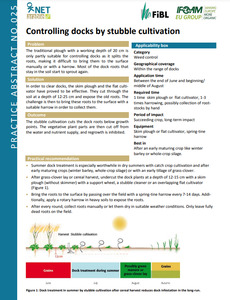{Tool} Controlling docks by stubble cultivation (OK-Net Arable Practice Abstract). [Sommer-Ampferkur durch Stoppelbearbeitung.] Creator(s): Dierauer, Hansueli; Siegrist, Franziska and Weidmann, Gilles. Issuing Organisation(s): FiBL - Research Institute of Organic Agriculture. OK-Net Arable Practice abstract, no. 025. (2017)
Preview |
PDF
- German/Deutsch
(Sommer-Ampferkur durch Stoppelbearbeitung)
257kB |
Preview |
PDF
- English
(Controlling docks by stubble cultivation)
189kB |
![[thumbnail of 2023-01-09 12_50_01-Controlling docks by stubble cultivation.png]](/31030/25.hassmallThumbnailVersion/2023-01-09%2012_50_01-Controlling%20docks%20by%20stubble%20cultivation.png)  Preview |
Image (PNG)
- Cover Image
- English
162kB |
Document available online at: https://orgprints.org/31030/
Summary in the original language of the document
The stubble cultivation cuts the dock roots below growth points. The vegetative plant parts are then cut off from the water and nutrient supply, and regrowth is inhibited.
Practical recommendation
• Summer dock treatment is especially worthwhile in dry summers with catch crop cultivation and after early maturing crops (winter barley, whole-crop silage) or with an early tillage of grass-clover.
• After grass-clover lay or cereal harvest, undercut the dock plants at a depth of 12-15 cm with a skim plough (without skimmer) with a support wheel, a stubble cleaner or an overlapping flat cultivator.
• Bring the roots to the surface by passing over the field with a spring-tine harrow every 7-14 days. Additionally, apply a rotary harrow in heavy soils to expose the roots.
• After every round, collect roots manually or let them dry in suitable weather conditions. Only leave fully dead roots on the field.
Information
• Plan deep-rooted crops and annual or perennial cover crops in the crop rotation in order to reduce the water and nutrient supply in deeper soil layers and thus impair the growth conditions for dock plants.
• After a short dock treatment sow a suitable catch crop as quickly as possible, and only leave the field fallow until autumn sowing of cereals, if you intend to perform a longer treatment.
• If the dock pressure is high, refrain from sowing 4-year, slowly growing mixtures.
Summary translation
Bei der Stoppelbearbeitung werden die Ampferwurzeln unterhalb der Erneuerungsknospen durchtrennt. Den vegetativen Pflanzenteilen wird die Wasser- und Nährstoffzufuhr entzogen und der Wiederaustrieb erschwert.
Vorgehen
• Eine Sommer-Ampferkur lohnt sich insbesondere in trockenen Sommern mit unsicherem Zwischen-fruchtanbau und nach früh räumendem Getreide (Wintergerste, Ganzpflanzensilage) oder bei vorgezogenem Kleegrasumbruch.
• Nach Kleegras oder der Getreideernte mit dem Schälpflug (ohne Vorschäler) mit Stützrad, Stoppelhobel oder gut überlappendem Flachgrubber die Ampferpflanzen 12-15 cm tief unterschneiden (Grafik 1).
• Wiederholt in Zeitabständen von 7–14 Tagen die Ampferstöcke mit der Federzinkenegge an die Ober-fläche befördern. In schweren Böden eventuell zusätzlich eine Kreiselegge einsetzen, um die Wurzeln freizulegen.
• Nach jedem Durchgang grosse Wurzeln von Hand einsammeln oder bei geeigneter Witterung vertrocknen lassen. Nur völlig abgestorbene Wurzelstöcke auf dem Feld liegen lassen.
Hinweise
• Tiefwurzelnde Kulturen und 1- bis 2-jährige Standardmischungen in die Fruchtfolge einplanen, um das Wasser- und Nährstoffangebot in tieferen Bodenschichten zu reduzieren und so die Wachstumsbedingungen für die Ampferpflanzen zu verschlechtern.
• Nach einer kurzen Ampferkur möglichst schnell eine geeignete Zwischenbegrünung säen und nur bei einer länger dauernden Kur das Feld bis zur Getreide-Herbstsaat brach liegen lassen.
• Bei hohem Ampferdruck auf die Saat von 4-jährigen, langsam wachsenden Mischungen verzichten.
| EPrint Type: | Practice tool |
|---|---|
| What problem does the tool address?: | The traditional plough with a working depth of 20 cm is only partly suitable for controlling docks as it splits the roots, making it difficult to bring them to the surface manually or with a harrow. Most of the dock roots that stay in the soil start to sprout again. |
| What solution does the tool offer?: | In order to clear docks, the skim plough and the flat cultivator have proved to be effective. They cut through the soil at a depth of 12-25 cm and expose the old roots. The challenge is then to bring these roots to the surface with a suitable harrow in order to collect them. |
| Country: | Switzerland |
| Type of Practice Tool: | Practice abstracts |
| Theme: | Nutrient management, Weed management |
| Keywords: | arable farming, mechanical weed control, nutrient management, perennial weed, weed management |
| Keywords: | arable farming, mechanical weed control, nutrient management, perennial weed, weed management |
| Agrovoc keywords: | Language Value URI English arable farming http://aims.fao.org/aos/agrovoc/c_36528 English mechanical weed control http://aims.fao.org/aos/agrovoc/c_24200 English nutrient management http://aims.fao.org/aos/agrovoc/c_330697 English perennial weeds http://aims.fao.org/aos/agrovoc/c_5697 English weed control http://aims.fao.org/aos/agrovoc/c_8345 |
| Subjects: | Crop husbandry > Soil tillage Crop husbandry > Weed management Farming Systems > Farm nutrient management |
| Research affiliation: | European Union > Horizon 2020 > OK-Net Arable > OK-Net-Arable Tools Switzerland > FiBL - Research Institute of Organic Agriculture Switzerland > Knowledge exchange > Advice European Union > Horizon 2020 > OK-Net Arable European Union > Organic Farm Knowledge |
| Horizon Europe or H2020 Grant Agreement Number: | 652654 |
| Related Links: | https://organic-farmknowledge.org/tool/31030 |
| Project ID: | ofk |
| Deposited By: | Forschungsinstitut für biologischen Landbau, FiBL |
| ID Code: | 31030 |
| Deposited On: | 18 Jan 2017 14:21 |
| Last Modified: | 02 May 2024 10:31 |
| Document Language: | English, German/Deutsch |
| Status: | Published |
Repository Staff Only: item control page

 Download Statistics
Download Statistics Download Statistics
Download Statistics
